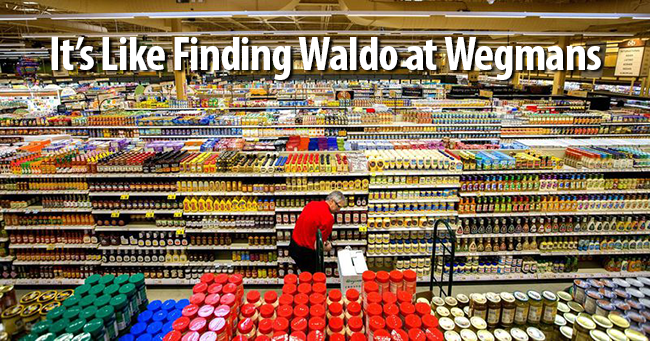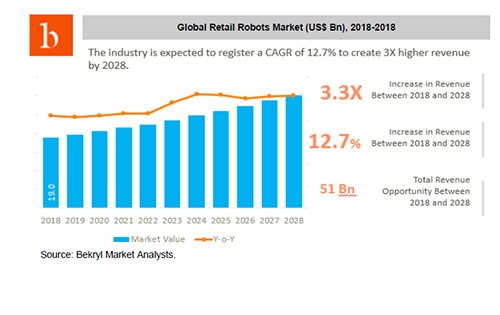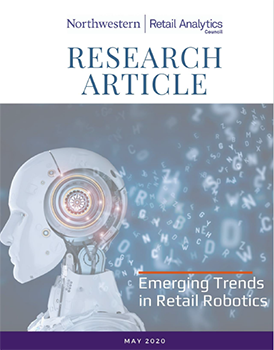
Emerging Trends
New Era for Retail Robots in Grocery Industry
“Movement toward multimodal robots that are efficient at performing various functions adds to the value equation”
“The smart retailers right now will actually look and see customer habits are changing more so than they ever have before,
so this is actually the greatest hall pass for experimentation that we’ve ever had.” —Chris Walton, Co-CEO, OmniTalk
Retail robots
A simple basket of grocery items, each handpicked by an in-store customer, represents an amazingly complex process. Even with a physical shopping list in hand, selecting goods from the over 30,000 different SKUs in an average supermarket, is fraught with difficulties, not the least of which is price.

Still, over 80 percent of U.S. shoppers, according to IBISWorld, prefer to make the trek to the supermarket and do all the picking. On average about $6,602 annually per household, $2,641 annually per person (based on the average 2.5 people in each household). Online shopping is but a fraction (4 percent) of the total $678 billion in grocery purchases each year.
With COVID suddenly jumping up online purchasing from 4 percent to between 12 and 15 percent, retailers are beginning to see an opportunity to automate the online process with robots.

“For retailers grappling with the complexity and pitfalls associated with developing an efficient online sales operation, the pandemic has presented a unique opportunity to experiment with new approaches to e-commerce. Grocers are at a rare point where they can test unproven concepts and reverse course relatively easily if the idea doesn’t resonate.”
“The movement toward multimodal robots that are efficient at performing various functions adds to the value equation. For example, McKinsey & Company estimates that various technologies, such as in-store labor automation and robotics operating simultaneously, can potentially add two to four percent to a retailer’s profitability.”
As Chris Walton, Co-CEO, OmniTalk, put it: “The smart retailers right now will actually look and see customer habits are changing more so than they ever have before, so this is actually the greatest hall pass for experimentation that we’ve ever had.”
It’s a “hall pass for experimentation” that must include retail robots, but what’s the state of the art in retail robots today? Can robots pick and pack SKUs efficiently enough to challenge humans?
We know that with high-speed computing, AI, RFID tags, and bar codes that robots are whizzes at processing grocery lists, and can get themselves to the Heinz ketchup in the condiment’s aisle in a reasonable amount of time. But once there, can a robot dexterously reach for the Heinz ketchup and adroitly place it into a shopping basket? Can it unpack the basket and bag it up for delivery? Tough jobs that are easy for a human to do quickly.
 Emerging Trends in Retail Robotics
Emerging Trends in Retail Robotics
The Retail Analytics Council (RAC) at Northwestern University took a look at retail robots for its 24-page research report: Emerging Trends in Retail Robotics (free download).
The report covers four broad areas:
- The impact on demand for robots in the grocery industry (pre- and during COVID)
- Estimates of the size of the global retail robot market
- Benefits associated with deploying robots in stores
- Review of U.S. retail robot deployments and the advancing of some emerging applications

Introduction
“Robots are increasingly being deployed in retail environments.1 The reasons for this include: to relieve staff from the performance of repetitive and mundane tasks; to reallocate staff to more value added, customer-facing activities; to realize operational improvements; and, to utilize real-time instore generated data.
“Due to the impact of the 2020 Coronavirus outbreak, we can now add a new reason to use robots in retail: to assist with customer and employee safety.
“We find that the trend toward deploying robots in retail environments is accelerating.
“The reasons for this include their functional utility, advances in AI, and the ability to address both labor challenges and customer and employee safety concerns. The introduction of new uses of real time, in-store generated data is another advantage.
“Further, the movement toward multimodal robots that are efficient at performing various functions adds to the value equation. We also find that changing consumer behavior to increase online purchases, especially in grocery, is a major impetus fueling this movement. Finally, establishing industry standards, which is ongoing, will fuel adoption.
“Previous impediments to adoption, which are not detailed here, are also at play. These, for the most part, include issues of cost and training. The costs of robots will decrease, and the ROI will greatly increase, as complex computing moves off the payload via 5G and sensor costs continue to decrease.
“Increased vendor competition will also be a factor. The cost and complexity associated with environmental training are also being addressed via the introduction of synthetic data.”
